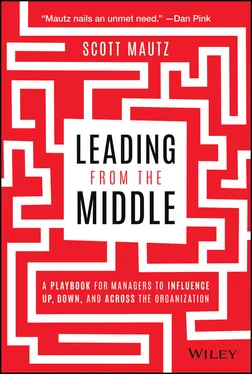Being in the middle means being subject to abruptness and unintended consequences all around. Sometimes you have to scrub and filter messages from others before passing them on, reworking the message to reflect its intent, not its poor execution. Sometimes, a mediator is needed in between parties to keep both sides positive and forward focused. Sometimes a layer is simply needed between the most senior leaders and those below to soften the blow of communications or actions.
The Role Play: Central to being a good buffer is purity of intent. If you have the right intent, you have the right to shape the content. It's not about withholding information or warping truth. It's about carefully molding communications and maintaining a positive culture to help the organization achieve its goals.
Those in the middle must straddle between long‐term objectives and short‐term goals, balancing the need to attend to both.
The Role Play: Key here is to not think of the long and short‐term as distinct entities. When considering long‐term objectives, evaluate current short‐term actions to ensure they feed the longer‐term objectives. It's easy to lose the plot and chase urgent priorities of the moment that are, in truth, inconsistent with achieving a long‐term objective. And when engaged in short‐term activities, pay attention to what you learn along the way and let it inform and inspire the formulation of long‐term objectives.
Fostering a sense of accountability isn't just about holding your employees accountable. It starts with you acting like an owner and holding yourself accountable, as well as holding senior managers accountable.
The Role Play: Author Peter Bregman has the essence of driving accountability exactly right—it's about achieving clarity on five things. Be clear on expectations, capability (resources and skills required to complete the work), measurement, feedback, and consequences. 15 It's as simple as that, but know that it's an all‐or‐nothing proposition. If you miss on any one of these five points, accountability will crumble.
19. Communicator, 20. Coach, 21. Team Builder
Each of these vital roles will be covered in depth in Chapters 3, 5, and 6, respectively.
Those who lead from the middle experience a breadth and depth of scope and roles like no one else in an organization. Revel in the choreographed dance you excel at. Believe that leading effectively from the middle is a craft and that you're on your way to becoming a craft master, something to take pride in. Know that you don't have to be the leader to be a leader. Realize that you're the center of progress, that you exist to make a profound impact and to infuse your workplace with energy and a winning attitude. Believe that you're a tour de force and attack your scope and roles with passion, fueled now by power plays for each scope and role challenge.
Know that leading successfully from the middle is also a mindset and a skillset. So, set your mind now to Chapter 2, where we open the playbook to learn the mindset required.
1 1. P. Evans, “Management 21C,” Chapter 5, Financial Times, Prentice Hall (2000), in Emerging Leadership: A Handbook for Middle Manager Development (IDeA).
2 2. “Why Middle Managers May Be the Most Important People in Your Company,” knowledge.wharton.upenn.edu(May 25, 2011).
3 3. B. Snyder, “Researchers: How Much Difference Does a Boss Make?” gsb.stanford.edu(September 27, 2012).
4 4. “The Middle Revolution,” tinypulse.com.
5 5. J. Caye et al., “Creating a New Deal for Middle Managers,” The Boston Consulting Group (July 2010).
6 6. J. Gehman, “Where Are They Now: Marty Lyons,” newyorkjets.com(November 8, 2018).
7 7. “Monkey Study Reveals Why Middle Managers Suffer the Most Stress,” manchester.ac.uk(April 2013).
8 8. J. Zenger and J. Folkman, “Why Middle Managers Are So Unhappy,” Harvard Business Review, hbr.org(November 2014).
9 9. S. Prins, L.M. Bates, K.M. Keyes, and C. Muntaner, “Anxious? Depressed? You Might Be Suffering from Capitalism: Contradictory Class Locations and the Prevalence of Depression and Anxiety in the USA,” onlinelibrary.wiley.com(August 2015).
10 10. E. Anicich and J. Hirsh, “Why Being a Middle Manager Is So Exhausting,” Harvard Business Review, hbr.org(March 2017).
11 11. Q. Huy, “In Praise of Middle Managers,” Harvard Business Review, hbr.org(September 2001).
12 12. J. Kain and S. Jex, “Karasek's (1979) Job Demands‐Control Model: A Summary of Current Issues and Recommendations for Future Research,” emerald.com(March 2010).
13 13. “Five Insights into Entrepreneurship,” www2.deloitte.com(2015).
14 14. S. Rock and M. Rock, “The Middle Manager Lifeline,” Think Publishing (September 2016).
15 15. P. Bregman, “The Right Way to Hold People Accountable,” Harvard Business Review, hbr.org(January 2016).
Конец ознакомительного фрагмента.
Текст предоставлен ООО «ЛитРес».
Прочитайте эту книгу целиком, купив полную легальную версию на ЛитРес.
Безопасно оплатить книгу можно банковской картой Visa, MasterCard, Maestro, со счета мобильного телефона, с платежного терминала, в салоне МТС или Связной, через PayPal, WebMoney, Яндекс.Деньги, QIWI Кошелек, бонусными картами или другим удобным Вам способом.












